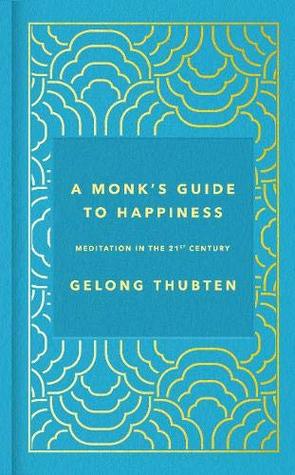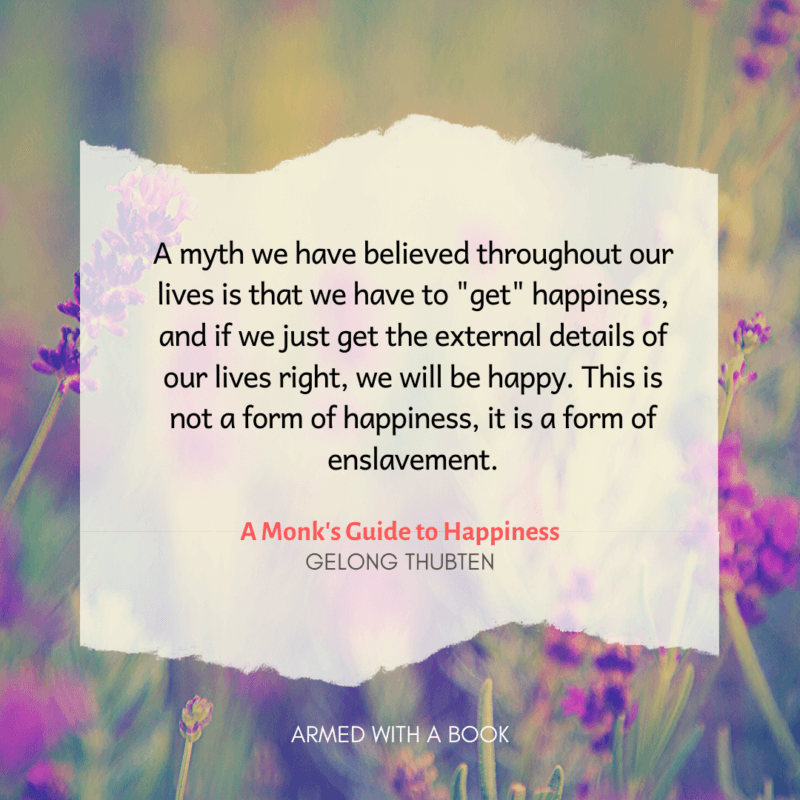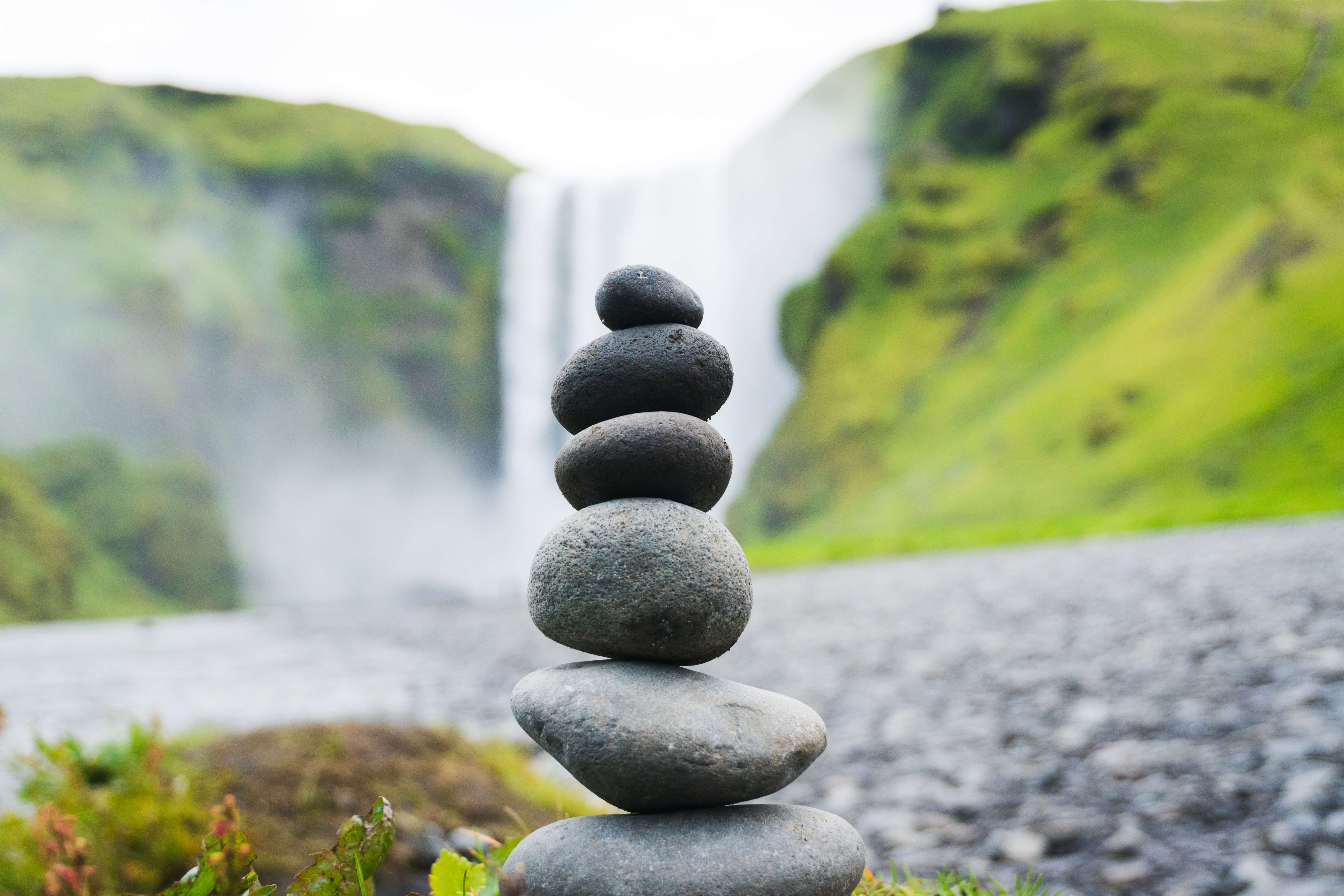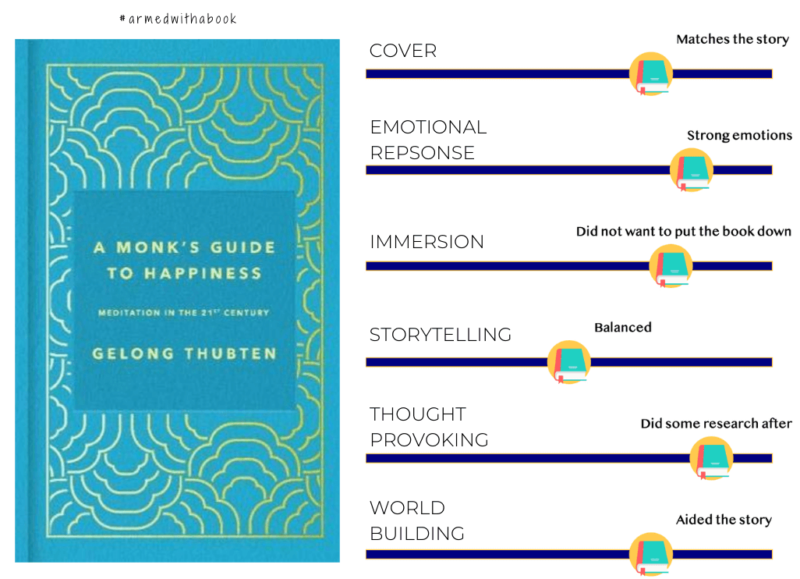Have you ever wondered about happiness? In our fast track lives where we hardly ever disconnect from the outside world, happiness often comes from comparing ourselves to others, being in a better position. But are we turning to extrinsic things too many times? I learned a lot about happiness and meditation from A Monk’s Guide to Happiness. Take a look at the synopsis and then we will dive in.

What is the secret to being happy? Does happiness come from outside us or do we need to look within? Can meditation help?
Gelong Thubten has worked with everyone from Silicon Valley entrepreneurs to Ruby Wax and Benedict Cumberbatch. In his warm and engaging debut book he explores the nature of happiness and explains how to bring meditation into our busy 21st-century lives with simple yet effective exercises.
Gelong Thubten, Buddhist monk, meditation teacher and author, has always been fascinated by the question of happiness. In his youth he tried to find it through living a wild and extreme lifestyle as an actor in New York. This only led to more unhappiness. Desperate for solutions, he found himself at a Buddhist monastery where he became a monk. After training his mind in intensive retreats he now helps many thousands of people worldwide, showing them how to find inner happiness and a greater sense of freedom.
His book can help you:
- Learn practical methods that help you to choose happiness
- Develop greater compassion for yourself and others
- Learn how to meditate in micro-moments during a busy day
- Discover that you are naturally ‘hard-wired’ for happiness
In this profound and inspiring book, Gelong Thubten presents a practical and sustainable approach to happiness, and how meditation and mindfulness can help us get there.
Thubten helps to bust the myth that our lives and minds are too busy for meditation. Reading this book could revolutionise your relationship with your thoughts and emotions.
Why I chose to read A Monk’s Guide to Happiness
You have heard me rave about Yael Shy’s What now?: Meditation for your Twenties and Beyond. When I saw this book on NetGalley, I was excited to take a step further into the journey of mindfulness, and meditation. Most important though was understanding the benefits of getting into meditation and how it relates to our physical and online worlds. I expected this book to be a deep study of our emotions and every day lives and I was not disappointed.
Themes for Thought
In recent months, I have wondered about society’s checklist and the progression of life that we are supposed to have, whether it is the age by which we should finish school or when we should be married and have kids by. A Monk’s Guide to Happiness starts off with confronting that myth.

On Freedom
We live in a world where we are always busy with something or the other and that has become the norm. In the chapter about stress in the 21st century, Thubten mentions that people often feel that they ‘need’ their stress. We tend to put stress on ourselves. It’s just what we do. Even if we have a couple minutes of reprieve, we go back to thinking about unsolved problems and upcoming events.
When I think in context of my own reading and writing habits, the numerous ways in which I manage both my book blog and my writing on the blog, I know I have put myself under some level of stress. If you are a close friend, you have heard me crib about being stressed about reading and how am I going to review all these books?! It’s all self imposed, and since engaging with A Monk’s Guide to Happiness, I recognize that more and more.
One of my biggest takeaway from this book was that happiness is freedom. I don’t know how I did not make that connection before! I am happy when I am reading and writing – I am doing what I want to do! My mind is free to concentrate on what is at hand. But apart from our passions, apart from gaining happiness from doing what we are doing in the moment, can happiness be removed from an action?

On Meditation and Mindfulness
Meditation and mindfulness help us practice being in the moment, whether it is by concentrating on our breath or doing a body scan, or just noticing the sensations that we feel when we are washing our hands. Thubten gives the example of being angry, which I found quite fascinating – when we are angry, we know we are angry, which means part of our mind isn’t angry and recognizes the anger. During meditation, we practice being aware of our thoughts. Letting the mind wander but come back.
Meditation is giving our mind complete freedom; it enables us to find space within, rather than from, the thoughts.
Thubten in A Monk’s Guide to Happiness
This book offers numerous little exercises and routines that we can tap into to make meditation and mindfulness a part of our lives. To find that space with our thoughts. Go to that area where we can just look at what else is going on. The one I really enjoyed doing was where I sat for 10 min and listened to my thoughts. It was such a neat journey because my mind was captivated by tattoos and how they are similar to alcohol. 🙂
On Self-Reflection
Yael Shy’s What Now?: Meditation for your Twenties and Beyond talked in depth about the concent of impermanence. Thubten mentions it as well, describing how reflecting on it helps us appreciate the time we have as well as remember the reality of things around us – ultimately, live ends and the time we have is precious.
We get bogged down by what is happening in our lives and sometimes get stuck in these never-ending cycles of the situation we are in. Between all the reviewing, I sometimes forget that I love reading, for example! A Monk’s Guide to Happiness presents the four ways of changing the mind and breaking the cycle. All we need to do is reflect on each of them:
- Confidence – the strong capacity we possess to learn, do and achieve things.
- Impermanence – nothing remains the same forever.
- Actions lead to results – what we do, say and think create our habits! [This is so ripe with opportunity to talk about habits!]
- Happiness and suffering come from the mind.
I find when I think of these four broad ideas, I feel better. I stop thinking about what i am doing and just marvel at where I am, not situationally but intellectually. I get a chance to appreciate time and me. 🙂 I hope these reminders help you take a step back and relax as well.
I learned a number of lessons from this book, and notes many areas that I need to think more deeply about. Infused with how-to meditation sessions that the reader can get into right away, as well as thought-provoking questions, A Monk’s Guide to Happiness is a book that I plan to return to over and over. I am confident that it has something for you as well and I encourage you to take a chance and give yourself the opportunity to think about what happiness really is as you read this book.
** A Monk’s Guide to Happiness is now out in stores so get a copy and let me know what you think! Let’s have a book-discussion! The US edition will be available in June. **
Amazon Print
Amazon Kindle

I am grateful to the publisher for providing me a complimentary copy of this book via Netgalley. It has been a pleasure to read it!
Cover image: Photo of the stones by Martin Sanchez on Unsplash

Be First to Comment